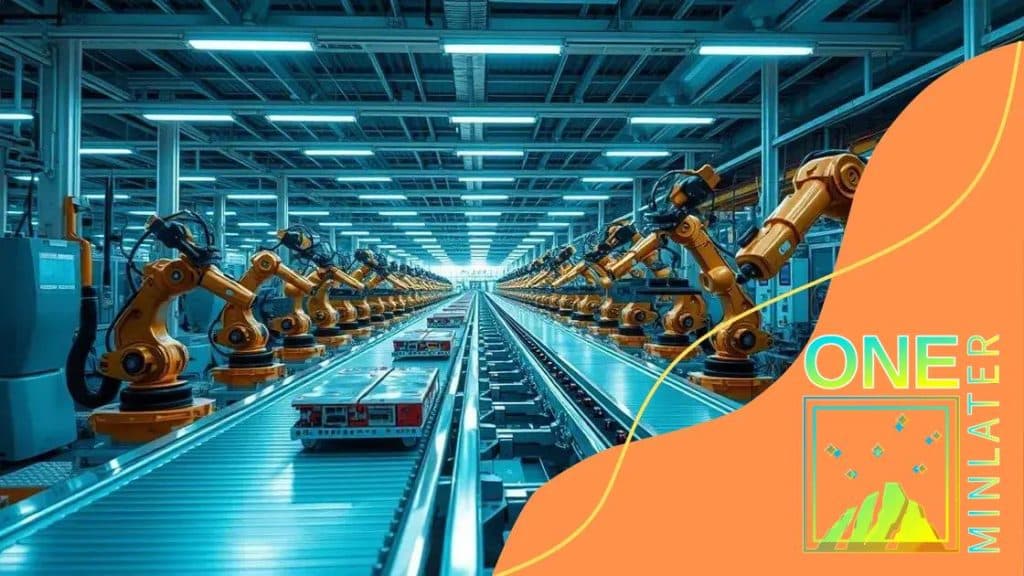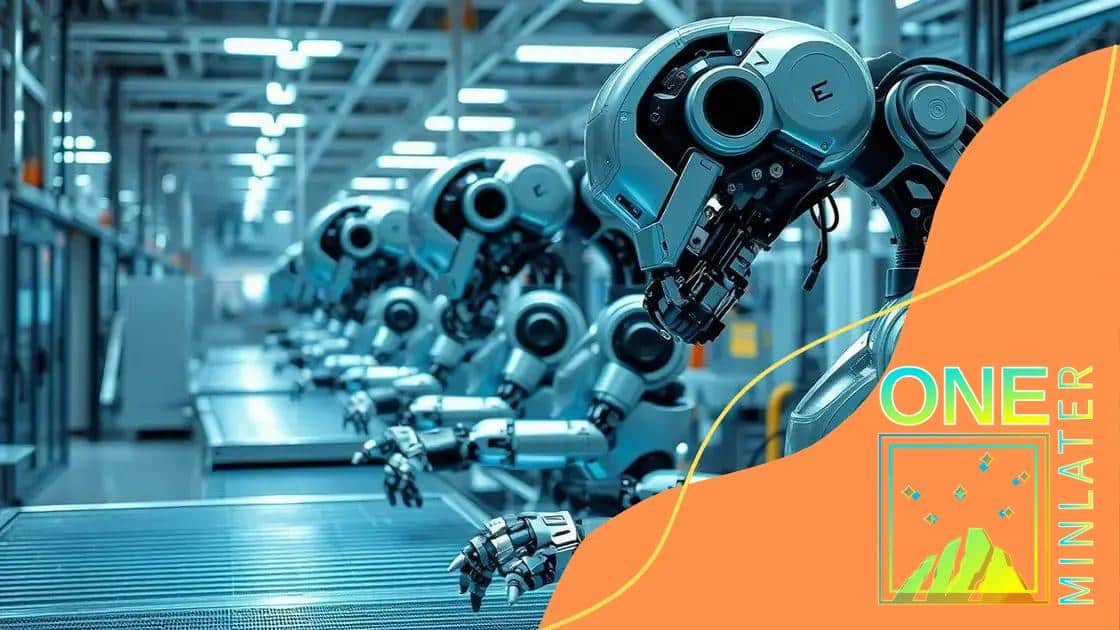The future of robotics in manufacturing industries

The future of robotics in manufacturing industries includes advancements like collaborative robots and enhanced AI, which boost productivity, efficiency, and workplace safety while addressing challenges like integration and cost.
The future of robotics in manufacturing industries looks promising, offering new efficiencies and capabilities. Have you ever wondered how your industry could change with robotics? Let’s delve into these exciting developments.
Advantages of robotics in manufacturing
The use of robotics in manufacturing brings numerous advantages that can transform production processes. These innovations not only streamline operations but also enhance overall efficiency. By integrating robots, companies can enjoy increased precision and reduced errors, which significantly contributes to higher product quality.
Key Benefits of Robotics
Implementing robots in manufacturing offers various benefits:
- Increased efficiency: Robots can operate continuously and handle repetitive tasks more quickly than human workers.
- Cost savings: Over time, the automation of tasks reduces labor costs and improves productivity.
- Enhanced safety: Robotics can perform dangerous tasks, minimizing workplace accidents.
- Improved consistency: Machines can produce identical products day after day without fatigue.
Moreover, the adaptability of robotic systems allows them to adjust quickly to changes in production needs. This flexibility is crucial in dynamic markets where consumer preferences can shift rapidly. Additionally, the data collected by robots can help manufacturers optimize processes further, using insights for better decision-making.
Greater Accuracy
Another advantage of utilizing robotics includes greater accuracy in tasks such as assembly and packaging. Robots are designed to perform with high levels of precision, which leads to fewer mistakes and waste. This level of accuracy significantly reduces costs related to rework and scrap materials.
Furthermore, advanced robotics can be equipped with sensors and AI to better analyze their environments. This means they can make real-time adjustments to maintain optimal performance levels. As technology advances, the capabilities of robotics continue to grow, providing even more benefits for the manufacturing industry.
Overall, the advantages of robotics in manufacturing are undeniable. They not only drive efficiency and reduce costs but also enhance safety and quality in production processes. Embracing these technologies can set a company apart in a competitive market.
How robotics enhance productivity
Robotics plays a crucial role in enhancing productivity within manufacturing industries. By integrating advanced technology, companies can achieve impressive output rates and minimize downtime. With robots, tasks that are repetitive and physically demanding can be performed efficiently, allowing human workers to focus on more complex and fulfilling jobs.
Improved Workflow
One of the ways robotics enhance productivity is through streamlined workflows. Automated systems can manage materials and parts in a more organized manner. This reduces the time spent on handling materials and increases overall efficiency.
- Automation of repetitive tasks allows employees to concentrate on higher-level responsibilities.
- Real-time data analysis helps in identifying bottlenecks and optimizing processes.
- Faster turnaround times lead to improved customer satisfaction.
- Consistent output quality minimizes defects and waste.
Furthermore, robotics can operate around the clock without the need for breaks or shifts. This capacity for continuous operation significantly boosts the quantity of output a facility can generate. As robots take over tedious tasks, human workers are liberated for more strategic activities, enhancing creativity and innovation in the workplace.
Collaboration with Workers
Another key aspect is how robotics collaborate with human workers. Modern robots are designed to work alongside employees safely. This collaborative environment not only increases productivity but also improves workplace morale. By combining the strengths of robots and humans, companies can achieve greater results than relying solely on either alone.
Robots gather data that can inform better decision-making. With this data, businesses can tweak operations for maximum effectiveness, resulting in higher production levels and enhanced product quality. As technology improves, the potential for robotics in productivity will only continue to grow, making it a vital component of future manufacturing strategies.
Key technologies driving robotics

Several key technologies are driving advancements in robotics, making it possible for these machines to perform increasingly complex tasks. As robotics continues to evolve, it integrates various innovations to enhance functionality and efficiency. These technologies not only improve performance but also make robots more accessible in different industries.
Artificial Intelligence
Artificial intelligence (AI) is at the forefront of robotic development. With AI capabilities, robots can learn from their experiences, adapt to new environments, and make real-time decisions. This ability to process information quickly improves their problem-solving skills and increases their versatility on the factory floor.
- Machine learning allows robots to improve their performance over time.
- Natural language processing enables robots to understand and respond to human commands.
- Computer vision helps robots recognize objects and navigate spaces effectively.
By utilizing AI, companies can create autonomous systems that require minimal human intervention. This not only increases operational efficiency but also allows for the handling of more sophisticated tasks.
Sensor Technology
Another significant contributor to robotics is sensor technology. Sensors equip robots with the ability to perceive their surroundings. This information is critical for robots to interact safely and effectively with both their environment and human workers.
Through advanced sensors, robots can detect changes in temperature, pressure, light, and proximity. This data is invaluable in ensuring precision and safety in operations. The integration of sensors has led to better feedback loops, resulting in smoother workflows and enhanced performance.
Moreover, advancements in actuator technology have improved the physical capabilities of robots. Actuators enable robots to move with greater dexterity and strength, allowing them to perform a wider range of tasks efficiently. Together, these technologies make robots more capable and reliable in various applications.
Challenges faced in robotic adoption
While the adoption of robotics offers numerous benefits, there are also significant challenges that industries must address. Understanding these hurdles is critical for a successful transition to robotic systems. Companies often face obstacles related to cost, integration, and workforce dynamics.
High Initial Costs
One major challenge is the high initial costs associated with acquiring and implementing robotic systems. Many businesses find it difficult to justify the upfront investment, especially small and medium-sized enterprises. The expenses involved in purchasing robots, along with necessary software and infrastructure upgrades, can be substantial.
- Budget constraints: Smaller companies may struggle with financing advanced technology.
- Return on investment: Determining when and how the investment will pay off can be challenging.
- Maintenance costs: Ongoing maintenance and updates can add to the overall expenses.
Despite these costs, the long-term benefits often outweigh the investment, making it essential to plan thoughtfully.
Integration with Existing Systems
Another significant hurdle is the integration of robots with existing manufacturing processes. Many companies have legacy systems in place that may not easily adapt to new technologies. Ensuring compatibility and minimizing disruptions during the transition can pose considerable challenges.
Companies often need to reassess their workflows, requiring a thorough understanding of both current operations and the new technology being introduced. This can lead to temporary delays and inefficiencies as employees adjust to changes.
Moreover, staff resistance to change can be another barrier. Employees may feel threatened by the introduction of robots, fearing job loss or feeling unsure about how to interact with new technology. This can create a culture of reluctance that hampers the effective use of robotics.
Strategic planning and education are crucial in overcoming these resistance barriers. As companies work to implement robotic solutions, engaging the workforce and providing training can facilitate smoother transitions. By proactively addressing these challenges, organizations can better leverage the advantages that robotics offer.
Future trends in robotics for industry
The future of robotics in industry promises exciting advancements that will reshape how we produce goods and deliver services. As technology continues to evolve, we can expect to see significant changes in many areas, enhancing efficiency and productivity.
Collaborative Robots
Collaborative robots, or cobots, are designed to work alongside humans in shared workspaces. This trend promotes a more interactive workforce, integrating robots into everyday tasks without replacing human workers. Cobots are equipped with advanced sensors and AI, allowing them to respond to human actions and collaborate effectively.
- Increased safety: Cobots are programmed to stop or slow down when humans are nearby.
- Flexible work environments: These robots can be easily relocated for different tasks.
- Cost-effective solutions: Cobots reduce the need for extensive safety measures, lowering integration costs.
As collaborative robots become more prevalent, industries can enjoy a boost in productivity while maintaining a comfortable work atmosphere.
Artificial Intelligence Enhancements
Another crucial aspect of the future of robotics is the integration of advanced artificial intelligence (AI) capabilities. As AI evolves, robots will not only perform tasks but also learn from their experiences, adapting to new challenges independently. This ability will revolutionize operations across various sectors, from manufacturing to logistics.
Robots equipped with AI will analyze vast amounts of data, providing insights that can help businesses optimize processes and improve decision-making. This can lead to increased operational efficiency and enhanced competitiveness in the market.
Additionally, predictive maintenance will play a significant role. With AI, robots can monitor their performance and alert teams before breakdowns occur, reducing downtime and maintenance costs. This technology fosters a more efficient manufacturing environment, where machines operate at peak performance.
Overall, the future of robotics in industry looks promising. Innovations such as collaborative robots and enhanced AI capabilities are set to redefine productivity and workplace dynamics, making industries more agile and responsive.
FAQ – Frequently Asked Questions about the Future of Robotics in Manufacturing
What are collaborative robots and how do they work?
Collaborative robots, or cobots, are designed to work safely alongside humans, performing tasks without the need for extensive safety measures.
How does artificial intelligence enhance robotic performance?
Artificial intelligence enables robots to learn from experiences, adapt to new situations, and make real-time decisions, improving their overall effectiveness.
What challenges do companies face when adopting robotics?
Companies often face high initial costs, integration with existing systems, and resistance from employees which can hinder the adoption process.
What future trends are emerging in robotics for industry?
Future trends include increased use of collaborative robots, enhanced artificial intelligence capabilities, and predictive maintenance for improved efficiency.





